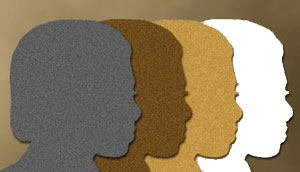White privilege in the Americas
By Dedrick Muhammad-Guest Columnist- | Last updated: May 11, 2009 - 3:03:40 PM
What's your opinion on this article?

Like in many capitalist societies, money can buy privilege, but in Latin America it can also buy you Whiteness. For generations Latin Americans have paid to change their race on their identification cards. Purchasing one's Whiteness has historically been a common practice for many Latinos of African descent. |
Latin America has a long history of White privilege and White supremacy and is colored with White privilege, from its political roots: U.S. implementation of Jim Crow in the Panama Canal, a brutal Dominican dictatorship that erased the African presence from its history and its culture, the massacre of hundreds of thousands indigenous Mayans in Guatemala, and “blancismento” (Whitetification) in Argentina (South America) in which governments actively recruited Europeans to emigrate to their nations in order to “Whiten” the society of its heavily indigenous and African populations.
To its social implications, White privilege has permeated Latin America's everyday language: “pelo malo” versus “pelo bueno” (good hair vs. bad hair), “negrita” used as both an insult and “term of endearment” for Latinos with “darker features,” and referring to one another by our race or complexion morena, trigueña, indio, zambo.
On March 31, 2009, Grupo Afro Descendiente sponsored a discussion entitled “White Privilege in Latin America: Myths and Realities” as part of White Privilege Awareness Week. The panel featured indigenous persons from Peru and Guatemala, an afro descendant from Cuba, a mestiza from Mexico, and an African immigrant from Cote d'Ivoire. Each panelist shared personal accounts, reflections on their experience with White privilege in Latin America.
What we found was that White privilege began and has been reinforced in society through socio-economic manipulation, cultural jokes/stereotypes, and paternalism often implemented by the Catholic Church and more recently the Evangelical movement. In every country in Latin America one will find that people of color are often the poorest, least educated, and least empowered/politically engaged in the society.
Even though there are high levels of integration in Latin America, intense segregation still exists. Often indigenous and Afro descendant populations live apart in communities that are somewhat isolated from the mainstream. This is prevalent throughout Central and South America among the garifuna and other indigenous Latin Americans. The country of Nicaragua for example is virtually divided into two countries by the rainforest: the West mostly inhabited by Whites and the East populated mostly by people of color.
This segregation is highlighted by the lack of Afro and indigenous presence on Latin American television. There are very few reflections of people of color in the Latino media. Sabado Gigante, the most popular variety program throughout all of Latin America is the greatest example of this phenomenon. With the exception of the occasional reggaeton or bachata artist and/or a futbol player, people of color are largely excluded as members of the cast and even in the audience of the popular program. Internalized racism of Latin Americans has led our community to deny or reject their African and/or indigenous heritage. This practice further reinforces the idealization of Whites in our society.
Further complicating the issue of White privilege for Latinos is living in a nation that has a different type of racial hierarchy than our homelands. The identity of Latino has practically become a racial category in this country. If you do not fit in the U.S. perceptions of Black or White or Asian (yes, there are Asian Latinos) you are designated as “Latino.” In the United States White supremacy followed the one drop rule, one drop of Black or Indigenous blood or any visible signs of these ancestries would exclude individuals of White privilege and condemn one to radicalized disenfranchisement. The ‘one drop of blood' was almost in reverse in Latin America; one drop of European blood or visible characteristics of European ancestry granted one access to some degree of White privilege and wealth, helping open the door for some people of color in Latin America to become part of the White elite of the country.
Like in many capitalist societies, money can buy privilege, but in Latin America it can also buy you Whiteness. For generations Latin Americans have paid to change their race on their identification cards. Purchasing one's Whiteness has historically been a common practice for many Latinos of African descent. Yet this practice did not challenge White supremacy, rather it found a loophole to gain access to White privilege. Our discussion of White privilege and the diverse racial characteristics of our communities allowed us to see that though the White supremacist socio-economic orders of our homelands are different than the ones found in the U.S., the deconstruction of White privilege is something that is needed throughout the Americas.
INSIDE STORIES AND REVIEWS
-
-
About Harriett ... and the Negro Hollywood Road Show
By Rabiah Muhammad, Guest Columnist » Full Story -
Skepticism greets Jay-Z, NFL talk of inspiring change
By Bryan 18X Crawford and Richard B. Muhammad The Final Call Newspaper @TheFinalCall » Full Story -
The painful problem of Black girls and suicide
By Charlene Muhammad -National Correspondent- » Full Story -
Exploitation of Innocence - Report: Perceptions, policies hurting Black girls
By Charlene Muhammad -National Correspondent- » Full Story -
Big Ballin: Big ideas fuel a father’s Big Baller Brand and brash business sense
By Bryan Crawford -Contributing Writer- » Full Story






 Click Here Stay Connected!
Click Here Stay Connected!








